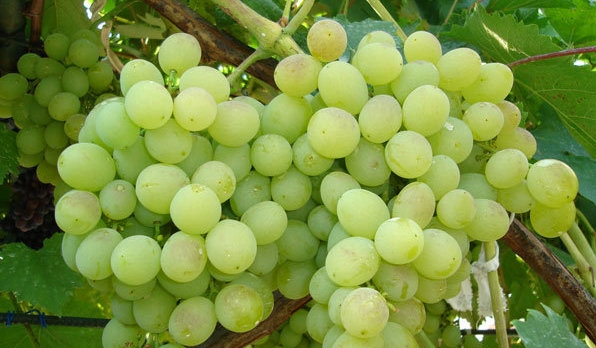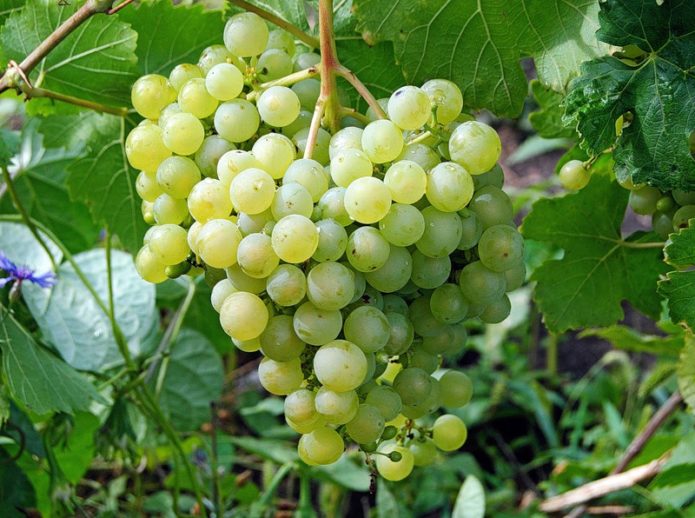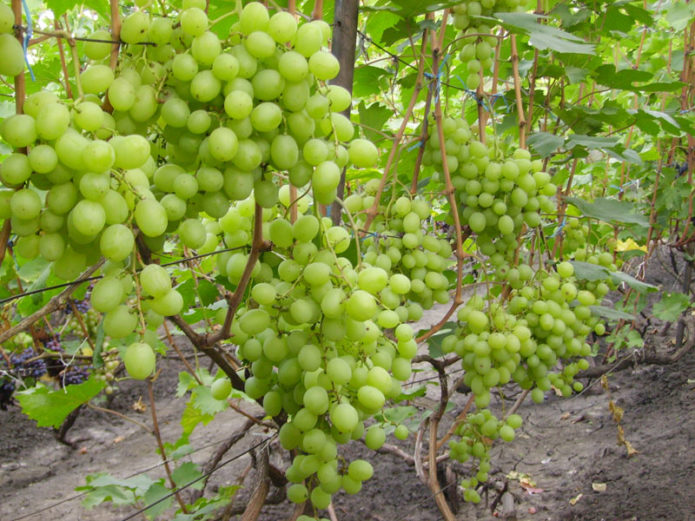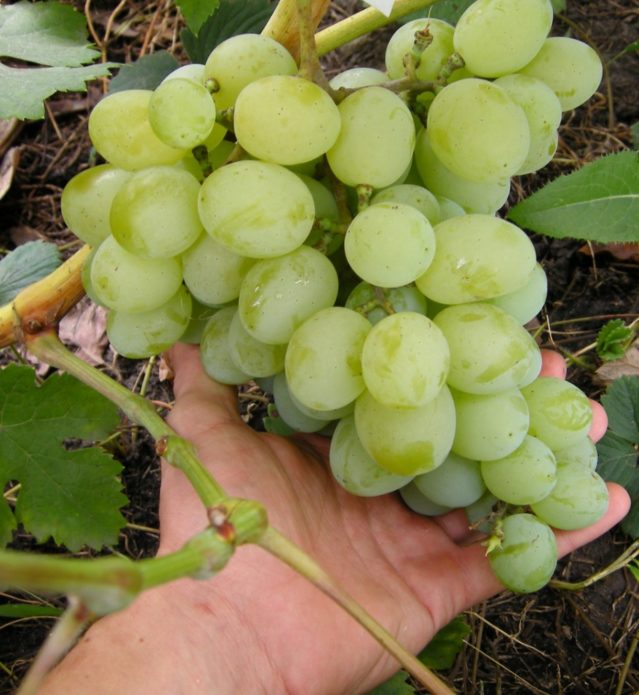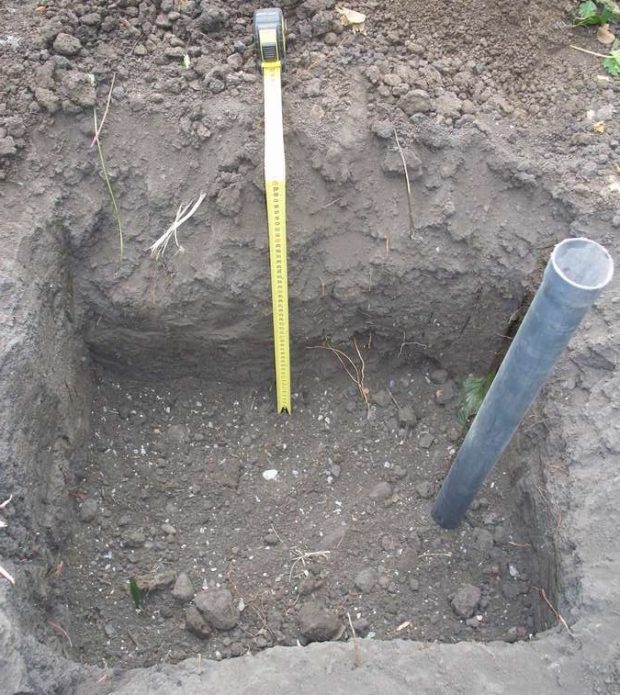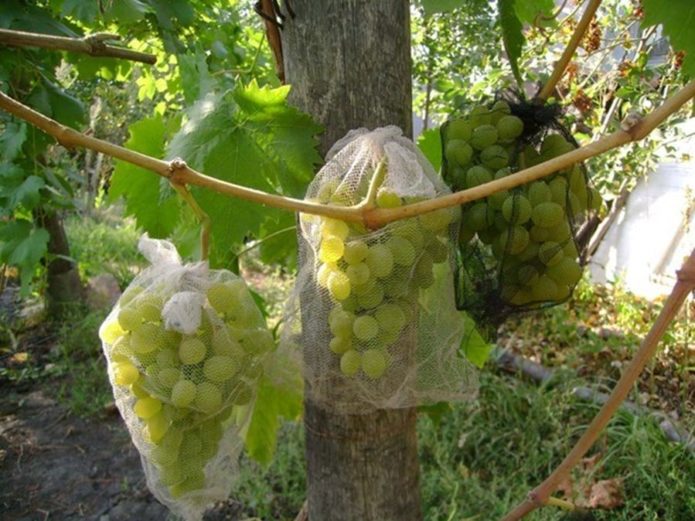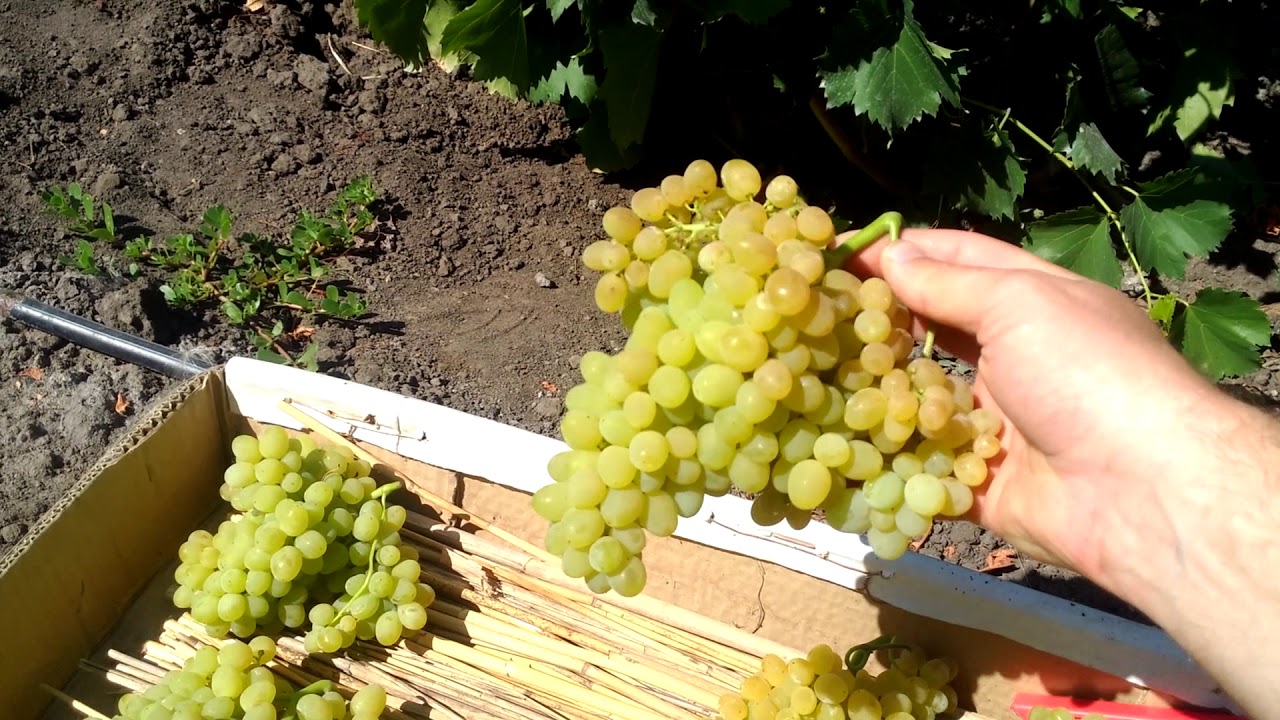The Talisman grape is a variety that has long earned recognition, although it has not yet turned thirty years old. In the years of his birth, he became a kind of sensation, since there were very few such varieties with high resistance to frost and disease, fruiting with large tasty berries. Nowadays, it is grown everywhere, but the main role of the variety is, perhaps, in the fact that many modern hybrid forms of table grapes are derived from it.
Content
Breeding history, description and characteristics of the grape variety Talisman
Domestic table grape variety Talisman received in 1990 at the VNIIViV them. Ya. I. Potapenko, Novocherkassk. The well-known variety Vostorg and Moldavian Frumoasa Albe (Belaya Krasavitsa) took part in the selection. Delight in general turned out to be a prolific "daddy": with his help, at the same institute, many wonderful grape varieties were bred, for example, Tamerlane, Timur, Sashenka, etc. The talisman, in turn, turned out to be in great demand for further breeding work.
This variety still successfully passes on to new hybrid forms of grapes such positive qualities as stable immunity to diseases, high yields and large-fruited. The Talisman itself, having quickly gained popularity in amateur and industrial viticulture, did not miss a high position for almost 30 years of its existence.
In addition to the main name, it is known as Kesha-1, Kesha-Muscat or Super Kesha, so we must try not to get confused when choosing a variety. There is, however, another opinion, it says that they are all different varieties, very similar, but differing in nuances.
Unfortunately, the Talisman has a significant drawback: pollinating bushes should be planted next to it, the choice of which is not so wide. The optimal varieties for pollination are Kishmish-342, Aleshenkin and Avgustin. In their presence, berries from the Talisman flowers are born almost 100%, but only in case of ideal weather. In troubled years, the variety requires additional artificial pollination. This was one of the factors due to which, in recent years, interest in the Talisman began to gradually fade: varieties of poor quality appeared that did not require pollinators.
The Talisman's bush is large, about 75% of the shoots are fertile and can withstand a load of at least two bunches each. If there are more of them, the extra ones should be removed so that the crop is of proper quality and does not contain so-called peas (very small berries among normal ones). The bush grows quickly, in the first year it gives a small bunch of berries, and from the second year after planting it begins to bear fruit regularly.It propagates in all possible ways, but the most popular is the rooting of lignified cuttings, which is almost 90% successful.
The frost resistance of the Talisman in the years of its appearance was considered very high, but now, according to this indicator, it is already among the majority of modern varieties: it can withstand frosts down to -25 aboutC. Therefore, in most regions, the variety requires light shelter for the winter. Its resistance to most grape diseases is above average. In general, it is believed that the level of its adaptability to variable climatic conditions is very high; it is not afraid of extreme heat or rainy cool weather.
In terms of ripening, the Talisman is considered an early grape. Sometimes it is classified as a very early variety, but this is not entirely true: after all, in most regions, the bulk of the harvest does not ripen until the end of August. The good thing is that ripe berries do not need to be urgently picked, they can remain on the bushes for a long time without loss of quality, sometimes even until the first weak frosts. The yield is high, but only with the right pollinators.
The Talisman's bunches are conical in shape, large, weighing on average about a kilogram. The berries are packed medium-dense and sometimes loose. The crop transportability is good. Berries are oval, very large, up to 3.5 cm in size and weighing 12 to 20 g. Color - greenish-white, with a yellowish tan on the sunny side.
Pulp with a high content of juice with sugar content up to 24% and acidity of about 8 g / l. The taste is excellent, but the nutmeg notes are weak and only in fully ripe grapes. The berries are covered with a very thin, intangible skin when eaten. The chemical composition and structure of the fruits allows them to be used both fresh and for all processing options.
Video: description of grapes Talisman
Features of planting and cultivation of the Talisman grape variety, including pruning
From the point of view of agricultural technology, the Talisman is no different from most modern table grape varieties. You just need to take into account that his bushes are very large, which should be remembered already when planting, as well as the fact that they cannot withstand the overload of the crop and require the removal of unnecessary bunches. Despite the fact that the rooting rate of cuttings is excellent, many growers prefer to graft the variety into the perennial wood of other, even more resistant varieties. When planting young bushes, you have to allocate a large area to them, leaving a distance of at least three meters to neighboring plantations.
The talisman can be cultivated in almost any climatic conditions, but it fully manifests itself only in the presence of a sufficient amount of heat and sunlight. This fact should be considered when choosing a landing site. It works best on chernozem soils, but any is suitable if it is filled with a sufficient amount of organic and mineral fertilizers.
The planting technique is well known to any gardener, it is not difficult. Subject to preliminary thorough digging of the site with the introduction of fertilizers, the size of the planting pit for the Talisman may not be very large: 60 x 60 x 60 cm is sufficient.On most soils, except sandy, drainage from pebbles or gravel and a vertical thick one must be placed in the pit a pipe for delivering water to the roots of a young seedling. All this is prepared in autumn, and grapes are planted in April, although autumn planting is also possible in the south. When planting, the seedling is deeply buried and watered well, and in the first year, regular watering is required.
Abundant, albeit rare, watering The Talisman also loves in adulthood, especially during the period of fruit growth.Top dressing is needed, first of all, with the use of ash and compost, special care must be taken when using nitrogen fertilizers. Since the variety suffers very rarely from fungal diseases, the only treatment of the vine with a solution of ferrous sulfate in early spring almost guarantees the absence of problems in this matter.
Wasps cause a big problem, you have to defend yourself against them in all possible ways. Destroying nests and hanging sweet baits with insecticides only partially saves the harvest, so many growers protect the most beautiful clusters by placing them in special nets.
The most difficult job in caring for grapes is skilled pruning, which cannot be learned right away. The easiest way is in the spring: long before the sap flow, immediately after the bushes open from hibernation, it is necessary to remove the broken and obviously dead shoots. Then the work on the formation of the bush continues all summer. As soon as young shoots appear that are clearly not growing in place, they must be broken out by hand, while they are still very short. The same applies to stepchildren emerging from the leaf axils. The main pruning is easiest to do after the fall, when all vines are clearly visible. For the Talisman, it is recommended to shorten all the shoots so that no more than 7 eyes remain on them. At the same time, the total number of shoots left is small: the maximum load for the entire bush is up to 32 buds.
In late autumn, the vines are removed from the trellises, laid out on the ground, tied in bunches and lightly covered. In most regions, it is enough to spread spruce or pine spruce branches on them; in the northern regions, it is worth adding sheet materials such as slate or pieces of roofing material. They remove the shelter in the second half of March, with the onset of real spring.
Video: ready harvest of the Mascot on the bushes
Advantages and disadvantages of the variety in comparison with similar
At the time of its appearance, the Talisman was one of the best early table varieties and could, for example, be compared to Arcadia. The advantage of the Talisman in this pair is the earlier readiness of the harvest, the disadvantage is the requirement for pollinators. At the present time, a lot of early varieties have appeared that surpass the Talisman in many respects (Long-awaited, Libya, etc.), but in their totality it still remains a very good variety, although it is slowly losing ground. The main advantages of the Talisman include:
- stable and high yield;
- large clusters and berries in them;
- great taste with signs of nutmeg;
- excellent transportability;
- long-term preservation of berries, including on bushes;
- increased frost resistance;
- high resistance to diseases;
- almost complete rooting of cuttings;
- adaptability to changing climatic and soil conditions.
The main disadvantage is the need for pollinators near the bush. There are others, albeit less significant:
- the need to normalize the crop;
- the need for protection from wasps;
- a rather large supply area and the need for particularly durable trellis.
Of course, all these relative disadvantages are quite surmountable, which is proved by at least the fact that numerous growers who have planted the Talisman variety on their plots are in no hurry to get rid of it.
Feedback and discussion
On specialized forums, a large number of branches are devoted to discussing the positive and negative sides of Talisman grapes. And, although recently attention to it has diminished, lovers still share their impressions of the variety and tips for caring for the plantings.
I want to share my observations about the resistance of this variety. In 2004, the Talisman bush was left on the old site, since it was not possible to transplant it due to its impressive size. In neighboring plots, all the grapes "burned" from mildew - not only bunches, but not even leaves.And the Talisman, lying on the ground, in the shade of three huge cherries, managed to give a few bunches and looked completely intact.
I cut off the last bunches of the Talisman on the gazebo. Almost all the bunches were perfect, the berries are dense and very tasty. I don't have Muscat on my Talisman. Result: 64 bunches with a total weight of 45.4 kg, average bunch weight 0.710 kg, maximum 1.5 kg.
I have six Talismans. Three self-rooted (1.5 and 2.5 years), and three inoculations made on two Lydia bushes (older inoculation 3.5 years). This is my favorite grape variety. Only he (and Moldova) in my conditions * provide powerful growth, give stable large yields and are not afraid of overload. The talisman pleases the eye with its split leaves, powerful shoots, large clusters and berries and not as late (as in Moldova) ripening. Everyone passing by stares, and does not hide joy, having received even a small bunch. Vaccinated on the unfortunate, thin, frail 40-year-old People, the Talisman made her roots work to the fullest. This has shaken the theory that it is the rootstock that determines the growth of the plant. A talisman grown even from a shank often yields more than a kilogram even in my second year.
Good grade. Poorly pollinated because a functionally female type of flower, a pollinator is needed nearby. It is not without reason that almost everyone uses it in breeding (Krainov, Pavlovsky, Kapelyushny, etc.). The maximum brush last year was 2 kg, but this is not the limit.
Stable, predictable ... If not for this pea ... And so - at a height in all respects. Taste, size, everything is great. He also made me very happy that this year many varieties were struck by some kind of rot, cut out half a bunch, and on the Talisman all the berries, found only two with rot for the whole bush, and there is nothing else! I cut it, cut it ... and still several bunches hang and do not deteriorate, only the taste improves.
The other day, a neighbor brought her friend on an excursion: "This is the kind of grape you need to plant," shows, smacking his lips dreamily, "Ladies finger!" This is the Talisman received by my neighbor! I did not remember Alyoshenkin, although they were nearby.
Talisman grapes are distinguished by excellent berry taste, high yield, frost resistance and disease resistance. Unfortunately, it does not bear fruit without the presence of pollinators: vine bushes of specific varieties. In recent years, the popularity of the variety has fallen somewhat, but it finds application in science, with its help breeders are developing new grape varieties.
